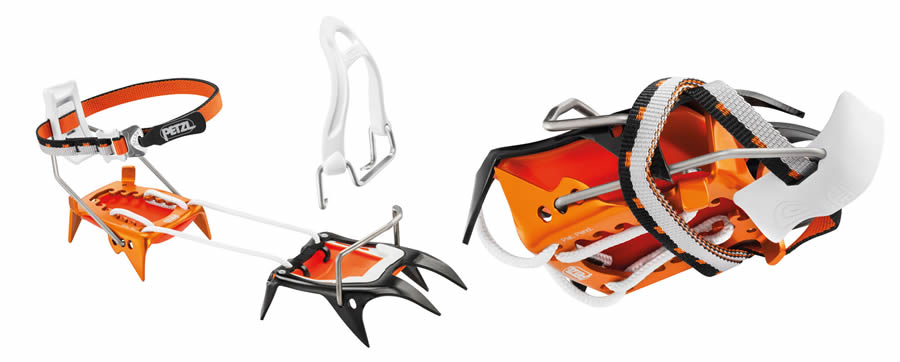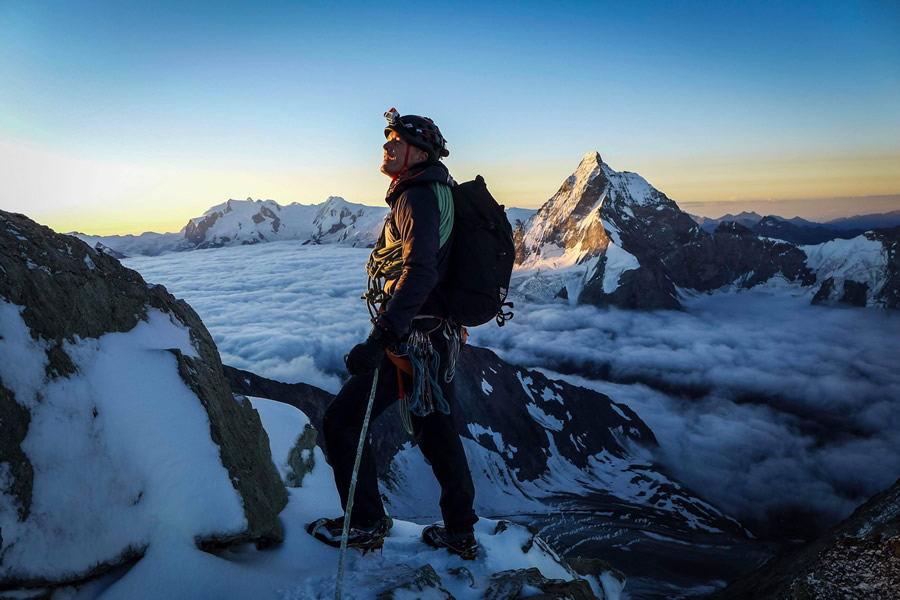Petzl’s dedicated ski mountaineering crampons series have been around a couple of years now which is more than long enough to test new technology and longevity. Petzl took a new approach to connecting the front and rear sections of the crampon and replaced the steel tension bar with dyneema rope or CORD-TEC in Petzl jargon. This not only reduces weight but also allows you to fold the crampons in half and reduce the overall pack size. Ross Hewitt takes a look...
Getting everything to pack down smaller is the holy grail and means my 27-32 litre pack works for everything from technical Chamonix day hits to 6 days hut to hut touring through the Alps. A compact pack brings its centre of gravity close to my back. The closer its centre of gravity is to my own the more it reduces the lever on my core muscles and helps me ski faster, longer and better. Light is right!

The Petzl IRVIS HYBRID crampons combine a steel toe piece connected to a lightweight heal piece with dyneema – perfect for ski mountaineering where you might be climbing up an alpine face and encounter some hard black ice or need to negotiate some sections of rock scrambling. The specified weight is 570 g with the anti-snow plates fitted. They come with both a wire and universal front bail so fit boots in the B2 & B3 categories.

Running out the rope between spike belays guiding Breche Tacul. Photo Sam Burrell
Out of the box I set my crampons up on my boots and went out ski touring in Arolla. We ended up climbing along a prolonged rocky ridge and after a while I noticed the toe piece had a tendency to yaw or skew to the side. – something a traditional crampon can’t do due to the torsional rigidity of the bar. I then realised the dyneema had ‘stretched’ to its working length and I just needed to adjust the tension. You can do this at home with the crampons fresh out of the box, putting them on and off the boot and tensioning using the hooks for the dyneema at first then micro adjusting by moving the heal bail a notch further forward.
So I’ve used these on everything from climbing the 700m 50/55 degree Col de la Verte ice face, guiding Dent Blanche and the Matterhorn or climbing fast and light alpine routes like the Peigne, Pelerins, Deux Angle, Plan, Midi traverse...

Ross Hewitt Climbing Col de la Verte. Photo Drew Tabke
...They are utterly brilliant and the dyneema stands up to all the abuse you can throw at it. After 2 years with around 400 days on the mountain, the aluminium heel has worn more than the dyneema so there are no worries about how robust these crampons are. I was particularly impressed with the quality of the steel and only recently sharpened them for the first time in preparation for skiing the North face of the Aiguille du Plan. In winter I used them on ski boots with the wire and in summer on the new fast and light Scarpa Ribelles with the universal bail. These are light so I only take the full aluminium LEOPARD crampons if I know I’m only going to travel over snow.
Unlike most crampons which are asymmetric, these crampons are identical except for the position on the buckle which would conventionally be on the outside of your foot. However, for steep skiing I put this on the inside as the body doesn’t not bend that well to do up crampon straps on the outside while hanging onto steep faces!

Ross Hewitt Guiding Dent Blanche. Photo Tim Neill
Ross Hewitt is an IFMGA guide based in Chamonix and a specialist in steep and remote skiing.
His descents include lines such as the the Matterhorn, the West Face of Mont Blanc, West Face of the Eiger, Frendo Spur, Brenva Spur, Mallory, etc, along with Alaskan trips. Ross enjoys exploratory skiing with 30 first descents in Baffin alone, 4 in Norway, and 2 major new lines in New Zealand.
Ross is supported by many brands including Black Crows Skis, Scarpa, Julbo, Petzl and Plum. The IRVIS HYBRID reviewed here were provided by Petzl as part of his sponsorship agreement.
Follow Ross on Instagram for some inspiration.









